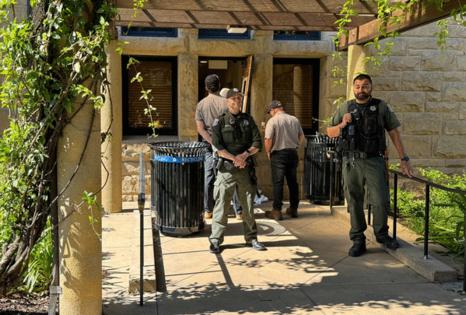Stanford: DA charges pro-Gaza protesters in June takeover of president's office
Published in News & Features
SAN JOSE, Calif. — Santa Clara County prosecutors have charged a group of pro-Palestinian protesters who were arrested last year after barricading themselves inside the president’s office at Stanford University while demanding the college remove pro-Israeli military support from its investment portfolio.
The district attorney’s office announced Thursday that it is charging felony vandalism and conspiracy counts against the demonstrators, who were arrested June 5 following their actions at the university’s executive offices, and were later accused of causing anywhere between $360,000 and $1 million in property damage. The threshold for felony vandalism in California is $400.
“Dissent is American. Vandalism is criminal. Speech is protected by the First Amendment. Vandalism is prosecuted under the penal code,” District Attorney Jeff Rosen said at a news conference Thursday morning.
The protesters, consisting mostly of current students and alumni, have had the cloud of criminal charges looming over them in the intervening months. The barricade situation occurred amid larger campus demonstrations demanding that the university divest from companies and other entities supporting Israel’s military actions in Gaza.
Rosen said all of those facing charges are U.S. citizens. The Trump administration has made headlines in recent days by revoking the visas of international students linked to the pro-Gaza movement.
As of Thursday morning, at least four of the people charged in the Stanford protest had self-surrendered to authorities for booking, Rosen said. He added that his office does not plan to pursue incarceration for the defendants, and that if they plead to the alleged crimes, they would likely be compelled to pay restitution and work in a jail-alternative program such as roadside trash pickup on the weekends.
“I don’t think this is a prison case,” Rosen said. “The way I see it, they damaged and destroyed all of this property and caused all this vandalism, and I think that their punishment should be cleaning things up.”
An arraignment date has not been set, pending the booking of all of the people who have been charged.
The Bay Area chapter of the Council on American-Islamic Relations said in response to the charges: “Prosecuting these young people with felony charges is a blatant attack on free speech.”
“We reject the notion that alleged financial damage should be used to justify silencing political dissent,” CAIR-San Francisco Bay Area Executive Director Zahra Billoo said. “If the threshold for criminalizing protest becomes monetary loss, then universities are prioritizing property over people and profit over principle.”
In the early morning hours of June 5, members of the group were recorded on security cameras — which were later covered and obscured — entering Building 10 by breaking a window and using ladders, furniture and other items to block doorways. From inside, they broadcast their political demands on social media.
About 90 minutes later, the Stanford Department of Public Safety, accompanied by the sheriff’s office, which provides sworn police services to the campus, made their way through the barricades and arrested the group.
Once inside, authorities contend that the group had ransacked the interior of the building, including damaging door frames and furniture and splattering fake blood. Upon their arrests, members of the group were found with tools including an electric grinder, hammers, crowbars and chisels.
The conspiracy charges are based on reported findings by investigators that group members extensively discussed planning the building intrusion on Signal, an encrypted text messaging service. Text threads addressed the patterns of security personnel and custodial staff at the building, provided a flow chart covering an array of entry strategy options based on how the building’s windows were secured, and attached literature including a “Do-It-Yourself Occupation Guide” that outlined tools and techniques to breach locks, windows and doors.
“We would not be here today if these defendants stopped at the threshold of Building 10 and simply stated their views,” Rosen said. “We would not be here today if the defendants had done what Stanford and universities all across our country try to instill in their students, to convince through the power of ideas, not the mayhem of a mob.”
Stanford spokesperson Dee Mostofi said the school respects the charging decision and noted that current students who were involved faced separate disciplinary actions from the university.
“Regarding Stanford’s internal disciplinary proceedings, panels from the Office of Community Standards found students responsible for violating university policies,” Mostofi said. “Sanctions included two-quarter suspensions followed by probation, delayed degree conferrals, and community service hours.”
Last month, the DA’s office announced its decision not to charge a Stanford Daily journalist who was arrested alongside the protesters, following a lengthy investigation that concluded the student was only present to chronicle the actions, and was not a participant.
That decision came after months of pressure from free-speech organizations who argued that he should have been swiftly cleared of criminal liability instead of being kept in a limbo state. Student groups similarly rallied behind the June protesters.
_____
©2025 MediaNews Group, Inc. Visit at mercurynews.com. Distributed by Tribune Content Agency, LLC.







Comments